
Luas is a tram system in Dublin, Ireland. There are two main lines: the Green Line, which began operating on 30 June 2004, and the Red Line which opened on 26 September 2004. Since then, the red line has been extended and split into different branches further out of the city and the green line has been extended north and south as a single line. Since the northern extension of the green line in 2017, the two lines intersect in the city centre. The system now has 67 stops and 42.5 kilometres (26.4 mi) of revenue track, which in 2023 carried 48.2 million passengers, an increase of 24% compared to 2022.
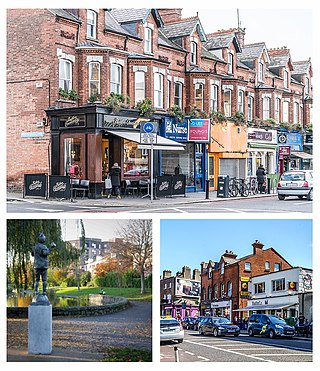
Ranelagh is an affluent residential area and urban village on the Southside of Dublin, Ireland in the postal district of Dublin 6.

Connolly station or Dublin Connolly is one of the busiest railway stations in Dublin and Ireland, and is a focal point in the Irish route network. On the North side of the River Liffey, it provides InterCity, Enterprise and commuter services to the north, north-west, south-east and south-west. The north–south Dublin Area Rapid Transit (DART) and Luas red line light rail services also pass through the station. The station offices are the headquarters of Irish Rail, Iarnród Éireann. Opened in 1844 as Dublin Station, the ornate facade has a distinctive Italianate tower at its centre.

Heuston Station, also known as Dublin Heuston, is one of Dublin's largest railway stations and links the capital with the south, southwest and west of Ireland. It is operated by Iarnród Éireann (IÉ), the national railway operator. It also houses the head office of its parent company, Córas Iompair Éireann (CIÉ). The station is named in honour of Seán Heuston, an executed leader of the 1916 Easter Rising, who had worked in the station's offices.

Spencer Dock is a former wharf area, close to where the Royal Canal meets the River Liffey, in the North Wall area of Dublin, Ireland. As of the 21st century, the area has been redeveloped with occupants of the Spencer Dock development including the Convention Centre Dublin, PricewaterhouseCoopers' Irish headquarters, Credit Suisse and TMF Group. The Central Bank of Ireland and NTMA have offices in the nearby Dublin Landings development.

Milltown is a suburb and townland on the southside of Dublin, Ireland. Milltown was the site of several working mills on the River Dodder and is also the location of the meeting of the River Slang with the Dodder. It is located adjacent to other suburban areas such as Windy Arbour, Ranelagh, Rathmines, Dartry, Clonskeagh, and Donnybrook.

The Red Line is one of the two lines of Dublin's Luas light rail system. The Red Line runs in an east–west direction through the city centre, north of the River Liffey, before travelling southwest to Tallaght, with a fork to Citywest and Saggart. The Red Line opened on 26 September 2004.

The Green Line is one of the two lines of Dublin's Luas light rail system. The Green Line was formerly entirely in the south side of Dublin city. It mostly follows the route of the old Harcourt Street railway line, which was reserved for possible re-use when it closed in 1958. The Green Line allows for passengers to transfer at O’ Connell GPO and Marlborough to Luas Red Line services and also allows commuters to use Broombridge as an interchange station to reach outer suburbs such as Castleknock and Ongar as well as Iarnrod Éireann services.
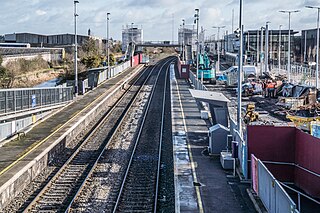
Broombridge is a railway station beside a Luas Tram stop serving Cabra, Dublin 7, Ireland. It lies on the southern bank of the Royal Canal at the western end of what had been Liffey Junction station on the erstwhile Midland Great Western Railway (MGWR). It takes its name from Broome Bridge, which crosses the canal, where William Rowan Hamilton developed the mathematical notion of quaternions. A plaque on the adjacent canal bridge and the name of the Luas Maintenance depot on site, Hamilton Depot, commemorates this.

The Harcourt Street Railway Line was a railway line that ran from Harcourt Street in Dublin through the southern suburbs to Bray. It was one of the Dublin and South Eastern Railway's two northern main lines, the other being the coastal line to Westland Row.

Broadstone railway station was the Dublin terminus of the Midland Great Western Railway (MGWR), located in the Dublin suburb of Broadstone. The site also contained the MGWR railway works and a steam locomotive motive power depot. A Luas tram station opened at the front of the station in 2017.

St Stephen's Green is a stop on the Green Line of the Luas (tram) system in Dublin, Ireland. Originally opened in 2004, it was further developed as part of the Luas Cross City project between 2013 and 2017.

Harcourt Street railway station is a former railway terminus in Dublin. The station opened in 1859 and served as the terminus of the line from Dublin to Bray in County Wicklow. It closed in 1958 following the closure of the Harcourt Street line. Since 2004, there has been a Luas tram stop outside the front of the old station.

The Rosie Hackett Bridge is a road and tram bridge in Dublin, Ireland, which opened on 20 May 2014. Spanning the River Liffey and joining Marlborough Street to Hawkins Street, it is used solely by public transport, taxis, cyclists and pedestrians. It is 26 metres wide and 48 metres long, and is a single span, smooth concrete structure, with the underside of the bridge designed to be as high above the water as possible so that river traffic is not impeded. It was built to carry the extended Luas Green line, and was budgeted at €15 million. It is named for trade unionist Rosie Hackett (1893–1976).
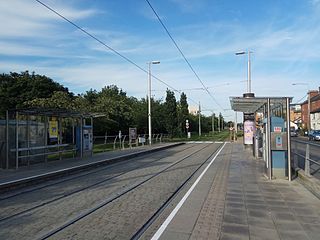
Rialto is a stop on the Luas light-rail tram system in Dublin, Ireland. It opened in 2004 as a stop on the Red Line. The stop is at the southern side of St. James's Hospital, adjacent to James's Walk, near the areas of Rialto and Kilmainham.
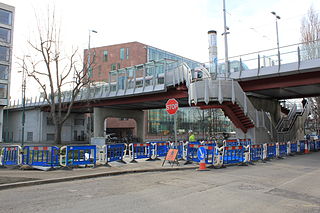
Charlemont is a stop on the Luas light-rail tram system in Dublin, Ireland. It opened in 2004 on the Green Line from St Stephen's Green to Sandyford. It provides access to parts of the south inner city, including Portobello.

Sandyford is a stop on the Luas light rail tram system in Dún Laoghaire–Rathdown, south of Dublin, Ireland which serves the nearby suburb of Sandyford. It opened in 2004 as the southern terminus of the Green Line, which re-uses the alignment of the Harcourt Street railway line which closed in 1958. Sandyford Luas stop is located on the same site as a station on the old line called Stillorgan.
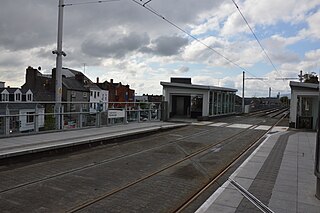
Ranelagh is a stop on the Luas light-rail tram system in Dublin, Ireland. It opened in 2004 as a stop on the Green Line from St Stephen's Green to Sandyford. It provides access to the urban villages of Ranelagh and Rathmines.

Milltown is a stop on the Luas light rail tram system in Dublin, Ireland which serves Milltown, Dublin and southern parts of Dartry, including Trinity Hall. It opened in 2004 as a stop on the Green Line, which re-uses the alignment of the Harcourt Street railway line which closed in 1958. Milltown Luas stop is located a few yards north of the site of the former rail station of the same name.

Dundrum is a stop on the Luas light rail tram system in Dublin, Ireland which serves the suburb of Dundrum. It opened in 2004 as a stop on the Green Line, which re-uses the alignment of the Harcourt Street railway line which closed in 1958. Dundrum Luas stop is built on the same site as a former heavy rail station of the same name.






















